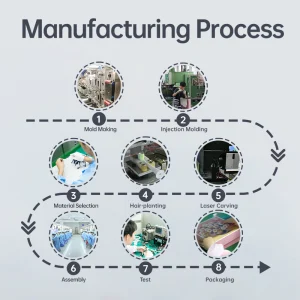When it comes to maintaining oral health, both water flosser traditional floss are popular choices for cleaning between teeth. Each method has its strengths and weaknesses, and choosing the right one often depends on individual needs and preferences. As a water flosser factory, we’ll explore the pros and cons of each option, along with practical usage tips of water flosser to help you achieve optimal oral hygiene.
Pros of Water Flossers
Efficient Cleaning:
Water flossers use a stream of pressurized water to remove plaque and debris. They are especially effective for individuals with braces, bridges, or implants. Studies show that water flossers can reduce bleeding gums and gingivitis more effectively than traditional floss in some cases.
Ease of Use:
Unlike traditional floss, which requires precision and manual dexterity, water flossers are user-friendly and can clean hard-to-reach areas with minimal effort.
Gentle on Gums:
For those with sensitive gums or dental work, water flossers provide a less abrasive cleaning method, minimizing discomfort.
Pros of Traditional Floss
Thorough Plaque Removal:
Traditional floss is highly effective at scraping plaque and debris off the surfaces of teeth, especially when used correctly.
Affordable and Portable:
Floss is inexpensive and easy to carry, making it a convenient option for maintaining oral hygiene on the go.
No Electricity Needed:
Unlike water flossers, traditional floss does not rely on batteries or charging, making it a dependable choice in any situation.
Cons of Each Option
Water Flosser Cons:
- Cost: Water flossers are generally more expensive upfront compared to traditional floss.
- Maintenance: Regular cleaning and refilling of the device’s reservoir are required.
- Size: Their bulkiness makes them less portable for travel.
Traditional Floss Cons:
- Technique-Dependent: Improper use can lead to gum irritation or damage.
- Limited Accessibility: It can be challenging to maneuver floss around dental work or tight spaces.
Usage Tips of Water Flosser
- Start on Low Pressure: For first-time users, start with the lowest pressure setting to get accustomed to the sensation.
- Use Proper Technique: Aim the water stream at a 90-degree angle to the gum line and move slowly along each tooth.
- Focus on Problem Areas: Spend extra time cleaning areas with dental work or where food tends to get stuck.
- Clean the Device Regularly: To maintain hygiene, clean the water reservoir and tips after each use.
Powsmart’s UVC water flosser for customization
1) 90s UVC sterilization function, make floss your teeth more hygienic;
2) 3 second gradual strengthening technology, easy and suitable for green hand;
3) Two water injection ports, easy and convenient to use;
4) Travel size but large capacity water tank, gravity ball design;
5) 3 different flossing modes, adjustable water pressure settings.

Conclusion
Both water flosser traditional floss have their advantages and drawbacks. While water flossers offer convenience and are ideal for individuals with special dental needs, traditional floss remains a cost-effective and reliable option for many. By understanding the unique benefits and limitations of each, and following expert usage tips of water flosser, you can choose the method that best fits your oral care routine and achieve a healthier, brighter smile. If you’re sourcing for water flosser for private labeling, don’t hesitate to contact Powsmart for a quote or sample test! https://www.powsmart.com/contact-us/





